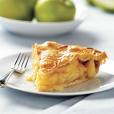
My mother would say that making good pie crust was the test of a real cook. Anyone can measure ingredients, stir them around, pour into a pan, and put into the oven. But making great pie crust is not only a science, but an art. With the correct proportions of moisture and fat comes the art of knowing how to shape and roll the crust ever so delicately, without sticking to the rolling pin or surface, and then transferring it to the pie plate without ripping it and destroying the beautiful appearance, especially of the top crust.
Many old cookbooks would not mention how much liquid to add to the flour and shortening. Cooks were expected to know this just by feeling the dough. And to some extent, this is true. Where I live in Florida, making pie crust in the summer time can be a real challenge with humidity levels as high as the temperature. So during the summer, I've found that pie crust needs a bit less shortening. If the full amount is used during high humidity, the crust can actually slide around on the pie. So for a crust calling for 3/4 cup shortening, take out 2 Tbsp of it. You'll barely have to add more ice water to the dough. Just add enough water so that the dough holds together without being crumbly, and not too much so that it's sticky. After making a few pies, you'll soon be able to get the feel for it. It should be nice and soft, holding together just right. (It's easier making pie crusts in more northern, less humid climates, such as Pennsylvania where I'm originally from.) And if you're ever making the dough, and it seems to come together nicely, and you still have water left to add, by all means don't add it. The correct amount of moisture may vary from time to time, from season to season, and even by the kind of flour you use.
Butter is nice to use in your pie crusts, but it is more difficult to work with. You'll most likely need less water in your recipe, and so you'll need to adjust accordingly. From my experience, the best fat to use in a pie crust, with consistent results, is vegetable shortening. Crisco works very well, and now there is even a trans-fat free Crisco, so that's what I use for most of my pies.
One tool I've become dependent on is a good pastry blender. The best type has blade-like cutters, like the one shown here.
 Pastry blenders with more wire-like cutters aren't as efficient, and you'll have to work a whole lot more. With a blade cutter, you're actually cutting the shortening into the flour, and moving the blades rapidly and in a slightly circular motion, you'll be able to combine all the shortening into the flour in about two minutes. Then add the ice water, combine gently, and you're ready to go.
Pastry blenders with more wire-like cutters aren't as efficient, and you'll have to work a whole lot more. With a blade cutter, you're actually cutting the shortening into the flour, and moving the blades rapidly and in a slightly circular motion, you'll be able to combine all the shortening into the flour in about two minutes. Then add the ice water, combine gently, and you're ready to go.For rolling the crust a good pastry mat is really helpful. You can get one from specialty cooking shops, or even at Target. There's also good silicone mats, so there's no reason why your pie crust should stick to the counter top.
Another tool I've improvised is a flour sprinkler. I have a parsley container, about 7 inches tall, with the large holes in the top for sprinkling parsley. Well I've used up the parsley about 10 years ago, and now I fill the container with flour for sprinkling on the pie crust and the rolling pin when rolling out the dough. The holes are just the right size so that the flour doesn't all pour out at once. I can sprinkle it exactly where I want it. It's also nice to re-cycle things in your kitchen if you can. This container has lasted 10 years for me, and I hope it lasts many more.
Don't be afraid to try your hand at pie crust. Remember how much fun you had as a kid with Play-Doh? You'll soon find yourself having a great time in your kitchen, playing with the pie dough, and loving the way it feels between your fingers. And as your pie bakes in the oven, you'll know that this is truly a labor of love. The love you put into your pastries will fill your family with happiness.
Let's go make a pie!
Basic Pie Crust
(for 2-crust pie)
(for 2-crust pie)
2 cups all purpose flour (unbleached is best)
3/4 cups vegetable shortening (try trans-fat free Crisco)
1/2 tsp salt
5 Tbsp ice-cold water
Mix flour and salt together in a mixing bowl. Add shortening, and mix into the flour with pastry cutter until it resembles cornmeal crumbs. (If you don't have a pastry cutter, you can use two knives, one in each hand, and move them back and forth in a scissor-like motion, to cut the shortening into the flour.) Add 4 Tbsp of ice water, and mix gently into the flour with your hands. If you can't bring the dough together into a ball, add the remaining water. If it still won't hold together, add more water, a little at a time, until it holds together when you press it into a ball. Don't add too much water, or your dough will be sticky and the finished crust will be tough. For best results and the flakiest pie crust, the dough should be handled as little as possible.
When you're ready to roll out the crust, cut dough into 2 pieces, one slightly larger than the other. The larger piece will be the bottom crust. Always use the smaller piece for the top crust. This recipe will make a double crust for an 8- to 9-inch pie.






No comments:
Post a Comment